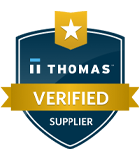BASICS OF CODE AND PRODUCT MARKING
Featured in Penton Media Publication - Machine Design - December 2, 2008
Summary:
Sprinter Marking's Marketing Manager explains the fundamental options and what to look out for when it comes to marking products. Topics include: how to handle different surfaces, inks, equipment options, and much more.
Actual transcript follows:
Editor of Machine Design magazine interviews the Marketing Manager at Sprinter Marking.
"He's here to talk a little bit with you about the printing technology available to engineers today.
I'd like to talk to engineering community about code marking equipment and specifically marking systems. One of the important things engineers must consider at the very beginning of their process is exactly what message that they want to convey on the product they are trying to mark and while that may seem simple often times it is fairly complex because there are quite a group of people involved with the message and it is important that that message be accurately identified to begin with because it will identify what pieces of equipment can be used to make that type of mark. There's a whole range of technology over the last forty years that has been brought to play with how code marking can be done. And today's technology, the most current technology that exists in the market place is laser technology that's fairly recent in the last ten years and is becoming more widely adopted and the cost of those machines are coming down and so that technology is being employed in more and more applications.
The old technology that we employ here has been part of the industry for many, many years. Where we apply code marks by taking ink and a reservoir system, we transfer it through an ink pad and then rubber dies collect the ink and actually then once the machine is fired or cycled it applies the ink impression to the surface to be marked.
So this technology is over fifty years old and there's still many companies producing wet ink transfer.
Ink jet technology is out in the market today predominately doing lots of marking and has a wide base of customers and applications for high speed marking of continuously moving products.
Another old technology still being employed today is heat transfer. Where perhaps a thermal transfer or hot stamping is used to mark systems where they employ films that have ink deposited on them the inks heated and it begins that process of applying that impression to the part.
One of the oldest technologies around is impact marking. Many manufacturers today still offer pieces of equipment that the customer has the component to be marked they will take and actually have mechanical force imbed the image into the product through metal dies.
Another technology used quite often today in many boxing or packaging operations are rollers. Roller coders where the contact of the roller actually twists the rubber dies in a circular pattern around the package to put a date code, product shift, or product number on the product.
Finally one of the technologies employed today is electrochemical where surfaces typically metal surfaces are etched. There are dies made for etching the process and mechanical components are then submitted to an electrolytic bath and an etching process goes on the surface to create a mark.
One of the things you need to consider at the very beginning is what is the physical size of the message to be delivered. There are all kinds of equipment that can do different types of message sizes. Ink jet systems can put on very long messages on a continuous basis as products run by them. We have a small piece of equipment here that does very small dot marking.
Most people in the wet ink transfer marking industry have pieces of equipment that can normally do up to two square inches of surface area so the message size is an important characteristic that the engineer must understand.
Does application speed determine the type of marking?
If you are running bottling line where you are running thousands of products an hour or minute it might direct you specifically to a machine or technology that can only do that type of marking. I'm thinking of ink jet technology which developed about 30 years ago or laser marking that brought the industry forward in allowing very high speed bottling processes to be date coded.
Does marking position play a role?
Yes, there are considerations on where, on the product it has to be marked as well as where in the process it has to be done. On the product if it has to be done on the bottom, side or top those all have implications on where equipment can be mounted and how it can be done. In the actual process itself there are limitations in a lot of customers operations where they are going back to try to establish a code mark where they find it is not possible to re-engineer their lines to accept machines so they have very limited spaces where components can be marked. So where it's marked and where it's at in the production line are very important parts to that.
What about mark durability?
In durability we have marks can be applied with water based inks where customers want to remove the mark in a downstream process. So they want something that's not very durable.
In other processes such as military components and airplane parts they want complete traceablity all the way through the life of the part and that may yield a different process to mark the part based upon the durability required.


